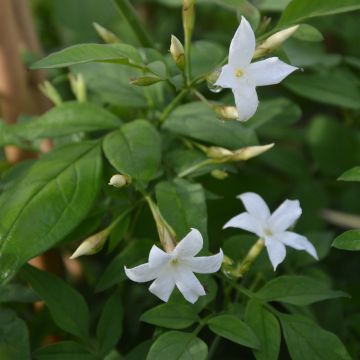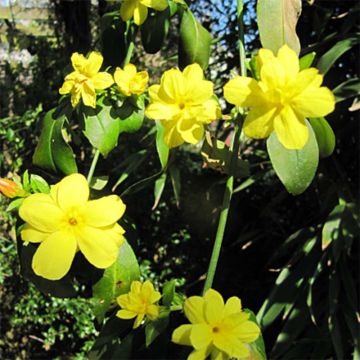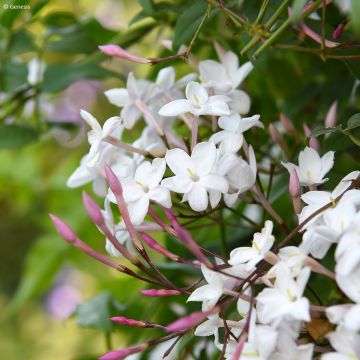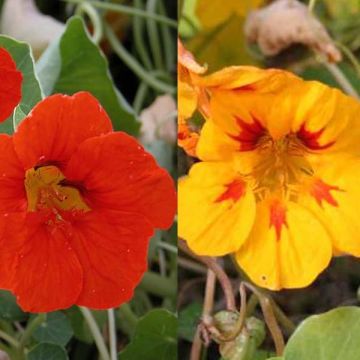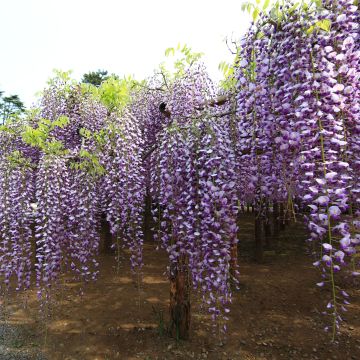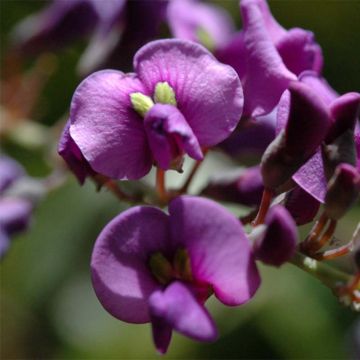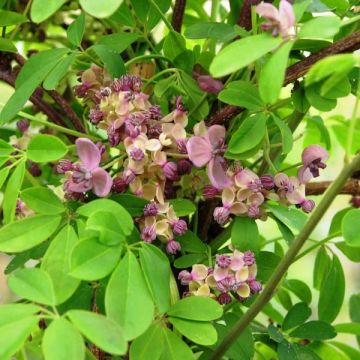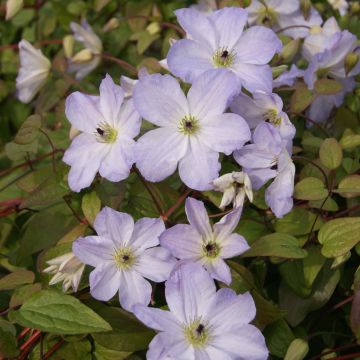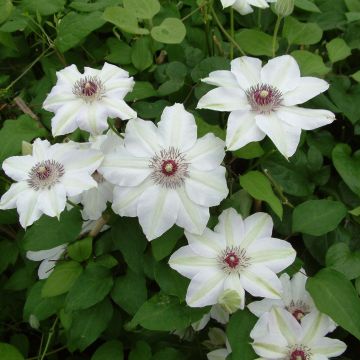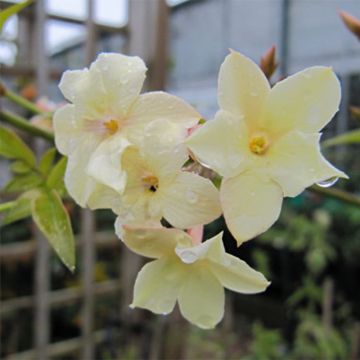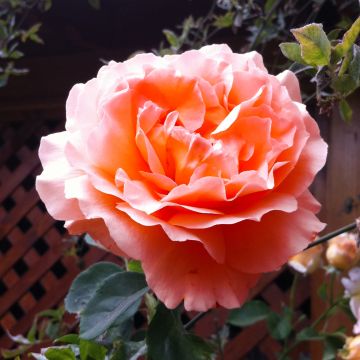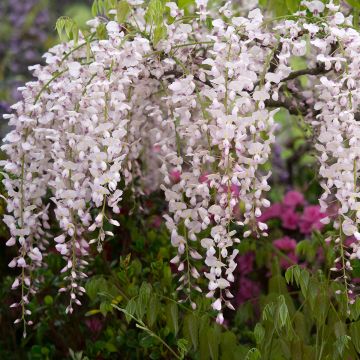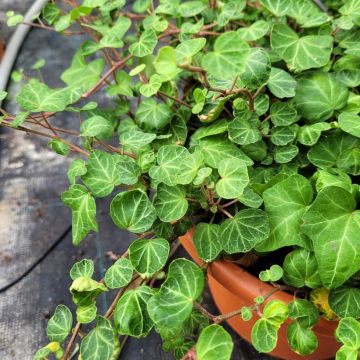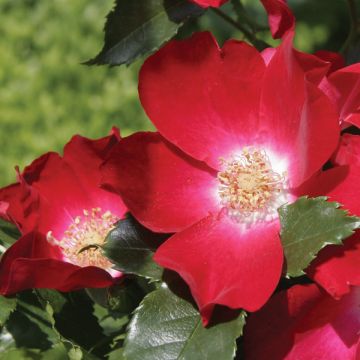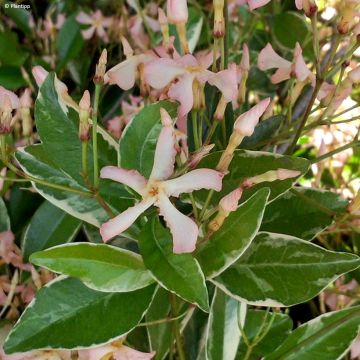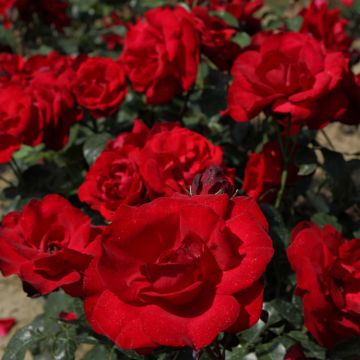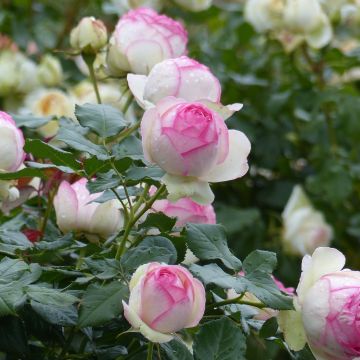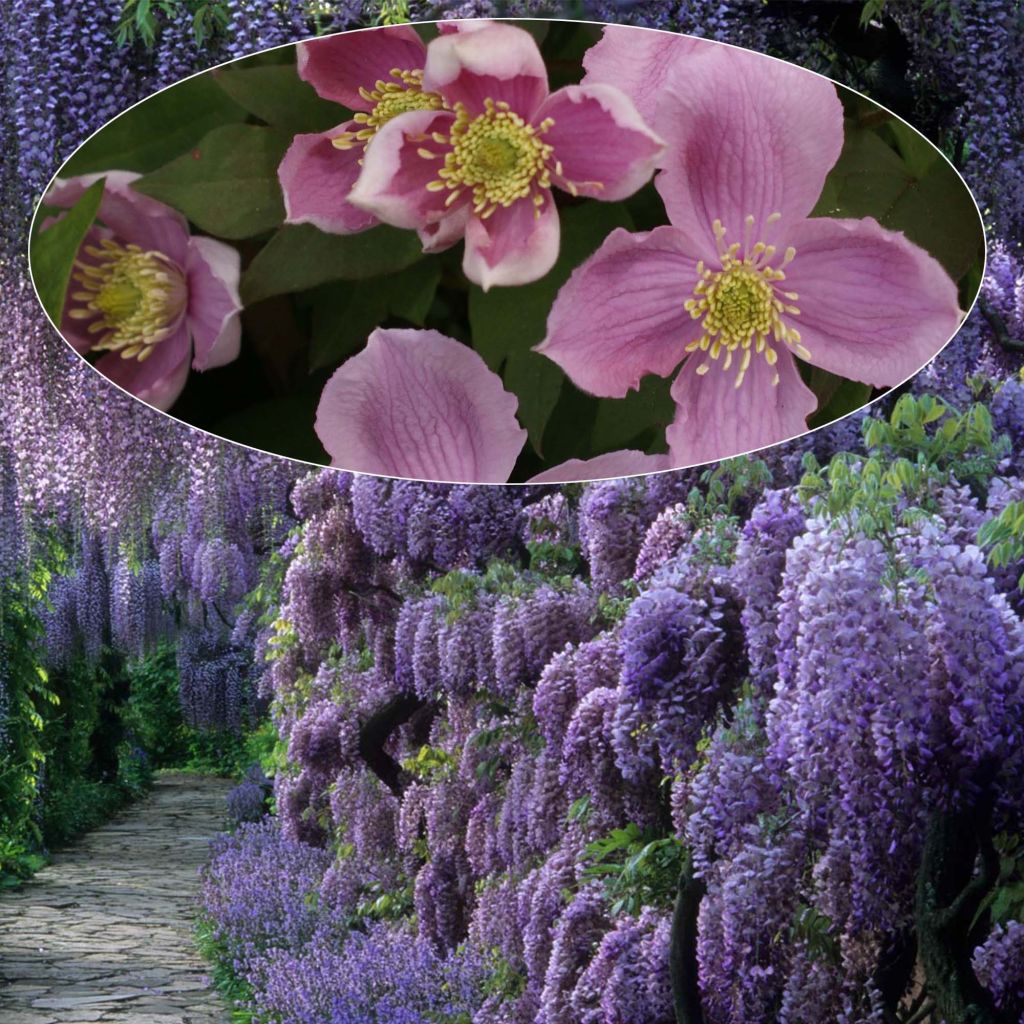

Duo 'The Giants' - Clematis montana Tetrarose and Wisteria sinensis
Duo 'The Giants' - Clematis montana Tetrarose and Wisteria sinensis
Clematis, Wisteria clematis montana Tetrarose, Wisteria sinensis
Products arrived dried and did not recover despite following the planting instructions properly, what a shame for the young plant.
Romain, 29/03/2023
This item cannot be shipped to the selected country
Delivery charge from €5.90
More information
Schedule delivery date,
and select date in basket
This plant carries a 6 months recovery warranty
More information
We guarantee the quality of our plants for a full growing cycle, and will replace at our expense any plant that fails to recover under normal climatic and planting conditions.
From €5.90 for pickup delivery and €6.90 for home delivery
Express home delivery from €8.90.
Does this plant fit my garden?
Set up your Plantfit profile →
Collection items (2 plants)
Description
A wonderful duo of giant and robust climbers, both originating from China: easily reaching or exceeding 8 metres (26 feet), the vigorous Clematis montana and the indomitable Wisteria sinensis complement each other perfectly to celebrate spring in the most beautiful way. The combination of these two inhabitants of wide open spaces offers a rare visual and fragrant spectacle in April-May. The pale lilac pink stars of the clematis, which exude the scent of vanilla and carnation, blend with the almost mauve clusters of Chinese wisteria, with their heavy floral fragrance. Make sure to provide enough space and a strong support to accommodate these two wonderful 'titans' of vegetation, whose stems can easily reach the tops of tall trees.
This duo 'The Giants' consists of a Clematis montana Tetrarose and a Wisteria sinensis plant.
The mountain clematis, in Latin Clematis montana, from the Ranunculaceae family, is a vigorous climbing plant with woody stems that loses its leaves in winter. This excellent hardy and accommodating garden plant is abundantly planted in many regions. The variety 'Tetrarose', can reach or exceed 8m (26ft) in height depending on the specific research area. Its leaves, a pretty bronze-green colour, turn purple when budding, and are composed of leaflets whose petioles wrap around any accessible support. Its 4-sepaled flowers appear in April-May. They are a pretty pinkish mauve, 4 to 6 cm (2in) wide, and are so numerous that they almost hide the foliage. They give off a sweet fragrance with hints of cloves, cocoa, and vanilla, and are followed by decorative feathery and silvery fruits that last until late winter.
Chinese wisteria, in Latin Wisteria sinensis, is an exuberant climbing plant belonging to the large Fabaceae family, just like clover, alfalfa, and lupins. Its long voluble stems, which can reach 10 to 20 metres (33 to 66 feet) in length, become woody with age. From spring to autumn, they bear light green, rounded, and numerous leaflets, giving the foliage a light appearance. The main flowering takes place in April-May, depending on the climate, at the same time as the clematis. It develops on almost naked branches located near the woody main stems. These are long lavender-coloured flower clusters that spread a sweet and flowery fragrance in calm weather. They open from the base towards the tip of the cluster. The plant reblooms slightly during the summer.
Both are deciduous plants in winter, perfectly resistant to cold, and undemanding in terms of soil (although Wisteria dislikes excessive limestone and Clematis montana does not like overly dry soil in summer). They will adapt to any good deep and well-drained garden soil, and a sunny to semi-shaded position.
Plant this duo of giants in a large informal hedge, place each plant on either side of a very solid long trellis, or let these two freely climb an old tree. The combination of mountain clematis and Chinese wisteria is one of the most romantic there is. These queens of climbing plants are capable of enhancing any structure, no matter how modest, sometimes ignoring the limits of your garden. Often surviving in old gardens from one generation to the next, when left to their own devices, they are faithful and extremely durable plants. To extend their wonderful flowering, one could associate this duo with a third scented giant: the rose 'Paul's Himalayan Musk', with pink flowers in June, or the 'Filipes Kiftsgate' climbing rose, covered in white clusters in summer.
Report an error about the product description
Plant habit
Flowering
Foliage
Botanical data
Clematis, Wisteria
clematis montana Tetrarose, Wisteria sinensis
Ranunculaceae, Fabaceae
Cultivar or hybrid
Other Spring flowering climbers
Planting and care
Clematis montana can be planted in spring or autumn, 5cm (2in) deep, with the root ball laid flat on the ground instead of vertically as usual. Plant with the head in the sun and the feet in the shade, for example protected by a flat tile. The soil should be well-drained, well-tilled, and fairly fertile. It should stay moist in summer, even though after a few years, the clematis can tolerate some drought. Cover the base with a small mound of soil to encourage new shoots. After planting, cut the stems back to 30cm (12in) from the base, above a pair of buds. Train them loosely to help the plant cling on its own later. Pruning afterwards will only consist of removing dead or damaged stems, in late winter or after flowering.
Chinese Wisteria is an easy-to-grow plant in all our regions, as long as the soil is sufficiently deep. It grows in any garden soil, with a preference for poor soils. However, it prefers an acidic to neutral soil and may wither in limestone soil. Once established, it withstands summer drought perfectly and does not require watering at all. Plant it along a wall or train it on a pergola. Pruning is recommended for better flowering. To improve the hardiness of Wisteria chinensis, plant it in a sufficiently well-drained soil, trained on a south-facing wall, it will withstand very harsh winters more easily. Wisterias can be trained as a tree by elevating them on a stake of 1.5 to 2m (5 to 7ft), or as groundcover.
Planting period
Intended location
Care
-
, onOrder confirmed
Reply from on Promesse de fleurs
Foolproof climbers
Haven't found what you were looking for?
Hardiness is the lowest winter temperature a plant can endure without suffering serious damage or even dying. However, hardiness is affected by location (a sheltered area, such as a patio), protection (winter cover) and soil type (hardiness is improved by well-drained soil).

Photo Sharing Terms & Conditions
In order to encourage gardeners to interact and share their experiences, Promesse de fleurs offers various media enabling content to be uploaded onto its Site - in particular via the ‘Photo sharing’ module.
The User agrees to refrain from:
- Posting any content that is illegal, prejudicial, insulting, racist, inciteful to hatred, revisionist, contrary to public decency, that infringes on privacy or on the privacy rights of third parties, in particular the publicity rights of persons and goods, intellectual property rights, or the right to privacy.
- Submitting content on behalf of a third party;
- Impersonate the identity of a third party and/or publish any personal information about a third party;
In general, the User undertakes to refrain from any unethical behaviour.
All Content (in particular text, comments, files, images, photos, videos, creative works, etc.), which may be subject to property or intellectual property rights, image or other private rights, shall remain the property of the User, subject to the limited rights granted by the terms of the licence granted by Promesse de fleurs as stated below. Users are at liberty to publish or not to publish such Content on the Site, notably via the ‘Photo Sharing’ facility, and accept that this Content shall be made public and freely accessible, notably on the Internet.
Users further acknowledge, undertake to have ,and guarantee that they hold all necessary rights and permissions to publish such material on the Site, in particular with regard to the legislation in force pertaining to any privacy, property, intellectual property, image, or contractual rights, or rights of any other nature. By publishing such Content on the Site, Users acknowledge accepting full liability as publishers of the Content within the meaning of the law, and grant Promesse de fleurs, free of charge, an inclusive, worldwide licence for the said Content for the entire duration of its publication, including all reproduction, representation, up/downloading, displaying, performing, transmission, and storage rights.
Users also grant permission for their name to be linked to the Content and accept that this link may not always be made available.
By engaging in posting material, Users consent to their Content becoming automatically accessible on the Internet, in particular on other sites and/or blogs and/or web pages of the Promesse de fleurs site, including in particular social pages and the Promesse de fleurs catalogue.
Users may secure the removal of entrusted content free of charge by issuing a simple request via our contact form.
The flowering period indicated on our website applies to countries and regions located in USDA zone 8 (France, the United Kingdom, Ireland, the Netherlands, etc.)
It will vary according to where you live:
- In zones 9 to 10 (Italy, Spain, Greece, etc.), flowering will occur about 2 to 4 weeks earlier.
- In zones 6 to 7 (Germany, Poland, Slovenia, and lower mountainous regions), flowering will be delayed by 2 to 3 weeks.
- In zone 5 (Central Europe, Scandinavia), blooming will be delayed by 3 to 5 weeks.
In temperate climates, pruning of spring-flowering shrubs (forsythia, spireas, etc.) should be done just after flowering.
Pruning of summer-flowering shrubs (Indian Lilac, Perovskia, etc.) can be done in winter or spring.
In cold regions as well as with frost-sensitive plants, avoid pruning too early when severe frosts may still occur.
The planting period indicated on our website applies to countries and regions located in USDA zone 8 (France, United Kingdom, Ireland, Netherlands).
It will vary according to where you live:
- In Mediterranean zones (Marseille, Madrid, Milan, etc.), autumn and winter are the best planting periods.
- In continental zones (Strasbourg, Munich, Vienna, etc.), delay planting by 2 to 3 weeks in spring and bring it forward by 2 to 4 weeks in autumn.
- In mountainous regions (the Alps, Pyrenees, Carpathians, etc.), it is best to plant in late spring (May-June) or late summer (August-September).
The harvesting period indicated on our website applies to countries and regions in USDA zone 8 (France, England, Ireland, the Netherlands).
In colder areas (Scandinavia, Poland, Austria...) fruit and vegetable harvests are likely to be delayed by 3-4 weeks.
In warmer areas (Italy, Spain, Greece, etc.), harvesting will probably take place earlier, depending on weather conditions.
The sowing periods indicated on our website apply to countries and regions within USDA Zone 8 (France, UK, Ireland, Netherlands).
In colder areas (Scandinavia, Poland, Austria...), delay any outdoor sowing by 3-4 weeks, or sow under glass.
In warmer climes (Italy, Spain, Greece, etc.), bring outdoor sowing forward by a few weeks.



































